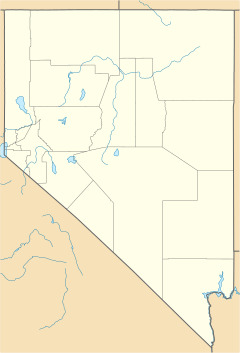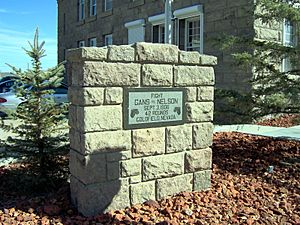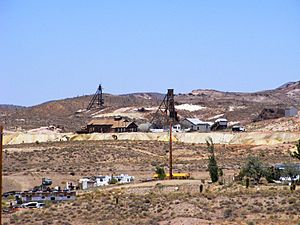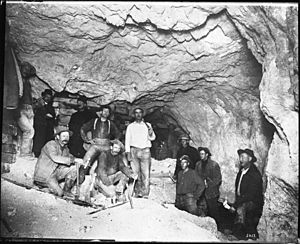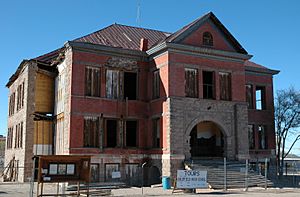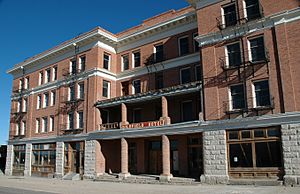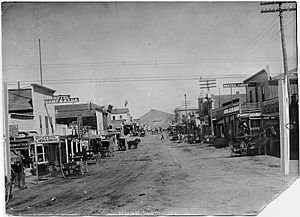Goldfield, Nevada facts for kids
Quick facts for kids
Goldfield
|
|
|---|---|
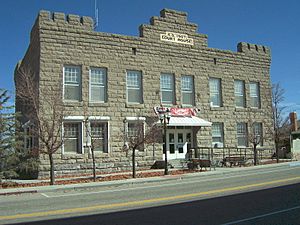
Esmeralda County Courthouse in Goldfield
|
|
| Country | |
| State | |
| County | Esmeralda |
| Founded | 1902 |
| Named for | Gold |
| Area | |
| • Total | 1.48 sq mi (3.84 km2) |
| • Land | 1.48 sq mi (3.84 km2) |
| • Water | 0 sq mi (0.0 km2) |
| Elevation | 5,686 ft (1,733 m) |
| Population
(2010)
|
|
| • Total | 268 |
| • Density | 181/sq mi (69.9/km2) |
| Time zone | UTC−8 (PST) |
| • Summer (DST) | UTC−7 (PDT) |
| ZIP code |
89013
|
| Area code(s) | 775 |
| FIPS code | 32-28900 |
| GNIS feature ID | 854468 |
Goldfield is an unincorporated community and the county seat of Esmeralda County, Nevada. It is a census-designated place, with a resident population of 268 at the 2010 census, down from 440 in 2000. Goldfield is located 247 miles (398 km) southeast of Carson City, along U.S. Route 95.
Goldfield was a boomtown in the first decade of the 20th century due to the discovery of gold – between 1903 and 1940, Goldfield's mines produced more than $86 million at then-current prices. Much of the town was destroyed by a fire in 1923, although several buildings survived and remain today, notably the Goldfield Hotel, the Consolidated Mines Building (the communications center of the town until 1963), and the schoolhouse. Gold exploration continues in and around the town today.
Contents
History
Gold was discovered at Goldfield in 1902, its year of inception. By 1904, the Goldfield district produced about 800 tons of ore, valued at $2,300,000, 30% of the state's production that year. This remarkable production caused Goldfield to grow rapidly, and it soon became the largest town in the state with about 20,000 people.
One prominent, or notorious, early Goldfield resident was George Graham Rice, a former check forger, newspaperman, and racetrack tipster, turned mining stock promoter. The collapse of his Sullivan Trust Company and its associated mining stocks caused the failure of the Goldfield State Bank in 1907. Rice quickly left Goldfield, but continued to promote mining shares for another quarter-century.
Another prominent resident from 1906 was George Wingfield, one of Nevada's entrepreneurs, who built the Goldfield Hotel. In collaboration with his partner George S. Nixon (who was to become a US senator in 1904), Wingfield started in Belmont, Nevada in 1901, and saw the potential of Goldfield after mining at Tonopah, 27 miles (43 km) north, took off. George S. Nixon and Wingfield made huge fortunes in Goldfield by forming the Goldfield Consolidated Mining Company. By 1906, they were worth $30 million.
Wingfield moved to Reno soon after realizing his great wealth could be spread across northern Nevada and northern California.
Between 1903 and 1918, mining in the two towns grew from $2.8 million to $48.6 million.
Wyatt and Virgil Earp came to Goldfield in 1904. Virgil was hired as a Goldfield deputy sheriff in January 1905. In April, he contracted pneumonia and, after six months of illness, he died on October 18, 1905. Wyatt Earp left Goldfield shortly afterward.
Goldfield reached a peak population around 20,000 people in 1906 and hosted a lightweight boxing championship match between Joe Gans and Oscar "Battling" Nelson.
In addition to the mines, Goldfield was home to large reduction works. The gold output in 1907 was over $8.4 million, the year in which the town became the county seat; in 1908, output was about $4,880,000.
By the 1910 census, its population had declined to 4,838. Part of the problem was the increasing cost of pumping brine out of the diggings, making them uneconomic. By 1912, ore production had dropped to $5 million, and the largest mining company left town in 1919. In 1923, a fire caused by a moonshine still explosion destroyed most of the town's flammable buildings. Some brick and stone buildings from before the fire remain, including the hotel and the high school.
Climate
Goldfield's climate is arid (Köppen climate classification BWk), bordering on semiarid.
An average of 35.9 afternoons with maximum temperatures of 90 °F or 32.2 °C or higher and 146.1 mornings with minimum temperatures of 32 °F or 0 °C occur. The record high temperature was 108 °F or 42.2 °C on July 20, 1906, and June 9, 1935. The record low temperature was −23 °F or −30.6 °C on January 21, 1937, although on average only 1.5 mornings fall to or below 0 °F or −17.8 °C and only 10.6 afternoons fail to top freezing.
The long-term average precipitation in Goldfield is 6.06 inches or 153.9 millimetres. An average of 29 days have measurable precipitation. The wettest calendar year was 1978 with 13.19 inches (335.0 mm) and the driest 1934 with 1.47 inches (37.3 mm). The most precipitation in one month was 6.07 inches (154.2 mm) in August 1931, and the most in 24 hours was 2.43 inches (61.7 mm) on June 19, 1918.
Average snowfall is 17.8 inches or 0.45 metres. The most snowfall in one year was 52.5 inches or 1.33 metres in 1969, including the record monthly snowfall of 42.0 inches or 1.07 metres in February 1969.
| Climate data for Goldfield, Nevada (1906–2009) | |||||||||||||
|---|---|---|---|---|---|---|---|---|---|---|---|---|---|
| Month | Jan | Feb | Mar | Apr | May | Jun | Jul | Aug | Sep | Oct | Nov | Dec | Year |
| Record high °F (°C) | 67.0 (19.4) |
76.0 (24.4) |
79.0 (26.1) |
87.0 (30.6) |
97.0 (36.1) |
108.0 (42.2) |
108.0 (42.2) |
103.0 (39.4) |
98.0 (36.7) |
87.0 (30.6) |
79.0 (26.1) |
66.0 (18.9) |
108.0 (42.2) |
| Average high °F (°C) | 42.2 (5.7) |
47.1 (8.4) |
54.2 (12.3) |
62.5 (16.9) |
71.3 (21.8) |
81.4 (27.4) |
89.6 (32.0) |
87.4 (30.8) |
79.0 (26.1) |
66.5 (19.2) |
52.9 (11.6) |
43.3 (6.3) |
64.8 (18.2) |
| Daily mean °F (°C) | 31.3 (−0.4) |
35.7 (2.1) |
41.6 (5.3) |
48.8 (9.3) |
57.1 (13.9) |
66.1 (18.9) |
74.2 (23.4) |
72.1 (22.3) |
64.0 (17.8) |
52.7 (11.5) |
40.5 (4.7) |
32.4 (0.2) |
51.4 (10.8) |
| Average low °F (°C) | 20.3 (−6.5) |
24.3 (−4.3) |
29.0 (−1.7) |
35.2 (1.8) |
42.9 (6.1) |
50.9 (10.5) |
58.7 (14.8) |
56.9 (13.8) |
48.9 (9.4) |
38.8 (3.8) |
28.3 (−2.1) |
21.5 (−5.8) |
38.0 (3.3) |
| Record low °F (°C) | −23.0 (−30.6) |
−13.0 (−25.0) |
0.0 (−17.8) |
8.0 (−13.3) |
19.0 (−7.2) |
22.0 (−5.6) |
38.0 (3.3) |
36.0 (2.2) |
21.0 (−6.1) |
12.0 (−11.1) |
−1.0 (−18.3) |
−13.0 (−25.0) |
−23.0 (−30.6) |
| Average precipitation inches (mm) | 0.63 (16) |
0.77 (20) |
0.63 (16) |
0.54 (14) |
0.50 (13) |
0.37 (9.4) |
0.45 (11) |
0.52 (13) |
0.44 (11) |
0.44 (11) |
0.38 (9.7) |
0.39 (9.9) |
6.06 (154) |
| Average snowfall inches (cm) | 3.3 (8.4) |
3.7 (9.4) |
3.6 (9.1) |
1.9 (4.8) |
0.5 (1.3) |
0 (0) |
0 (0) |
0 (0) |
0 (0) |
0.7 (1.8) |
1.5 (3.8) |
2.6 (6.6) |
17.8 (45.2) |
| Average precipitation days (≥ 0.01 inch) | 3 | 3 | 3 | 3 | 3 | 2 | 3 | 2 | 2 | 2 | 2 | 2 | 29 |
Demographics
| Historical population | ||
|---|---|---|
| Year | Pop. | ±% |
| 1902 | 36 | — |
| 1903 | 400 | +1011.1% |
| 1904 | 1,600 | +300.0% |
| 1905 | 8,000 | +400.0% |
| 1906 | 20,000 | +150.0% |
| 1907 | 18,000 | −10.0% |
| 1908 | 15,000 | −16.7% |
| 1909 | 10,000 | −33.3% |
| 1910 | 4,838 | −51.6% |
| 1920 | 1,558 | −67.8% |
| 1930 | 692 | −55.6% |
| 1940 | 554 | −19.9% |
| 1950 | 336 | −39.4% |
| 1960 | 184 | −45.2% |
| 1990 | 655 | +256.0% |
| 2000 | 440 | −32.8% |
| 2010 | 268 | −39.1% |
| Source: U.S. Census | ||
The population decline continued throughout the 20th century and, by 1950, Goldfield had a population of only 275.
The 2000 census showed 440 people, 221 households, and 118 families resided in the Goldfield census county division. The racial makeup of the CCD was 93.2% White, 0.2% Black or African American, 2.0% Native American, 0.2% Pacific Islander, 1.4% from other races, and 3.0% from two or more races. About 5.2% of the population was Hispanic or Latino of any race.
Present-day attractions
While the unoccupied buildings of the town remain an attraction, they are not abandoned. Each building has an owner, many with plans to renovate the property. In addition, the Goldfield Days festival is held in August each year. The festival includes parades, booths, historical displays, and a land auction.
Among the buildings located within the Goldfield Historic District are:
- The 1906–08 Goldfield High School, which survived the fire of 1923/24, is in poor condition, but the Goldfield Historical Society has received a matching grant of $296,000 from the National Park Service under the "Save America's Treasures Grant Program".
- Esmeralda County Courthouse
- The 1907–1908 Goldfield Hotel at Crook Avenue (U.S. 95) and Columbia Street has remained unoccupied since the end of World War II.
In film
Parts of the cult classic 1971 car chase movie, Vanishing Point, were filmed in Goldfield, and it was the site of the fictitious radio station "KOW", and the DJ "Super-Soul". Goldfield also served as the fictional town of "Glory Hole" in the 1987 film Cherry 2000, and as the fictional California town in the 1998 film Desert Blue. The 2007 fictional film Ghosts of Goldfield is set in the Goldfield Hotel.
The town was featured in two episodes of State Trooper, Rod Cameron's syndicated television series that aired from 1956 to 1959. In 1957, Vivi Janiss joined Frank Ferguson as guest stars in the roles of Mabel and Frank Cliff in the episode, "No Blaze of Glory," a story of a presumed arson case with a surprise ending set in Goldfield. Goldfield is featured too in another State Trooper episode titled "The Prettiest Dress In Goldfield", which aired on January 1, 1959. Various buildings and streets can be recognized.
Notable people
- Ben Alexander, actor
- Samuel Langhorne Clemens
- Doris Dawson, actress
- Brad Dexter, actor
- Virgil Earp, deputy sheriff
- Joseph Rosenberg, banker and miner
- George Wingfield, banker and miner
Images for kids
See also
 In Spanish: Goldfield (Nevada) para niños
In Spanish: Goldfield (Nevada) para niños


